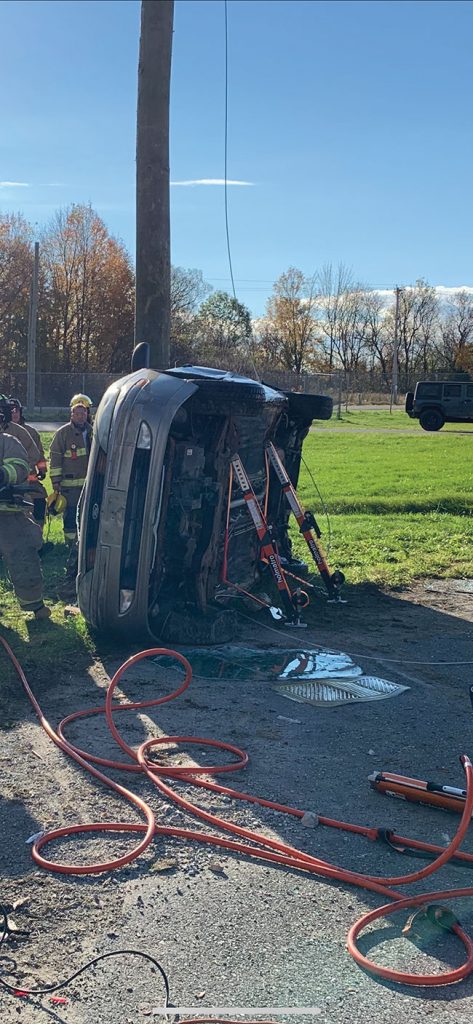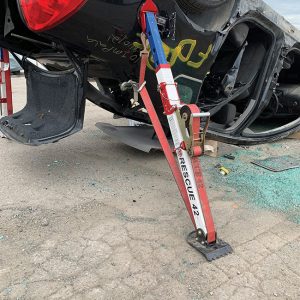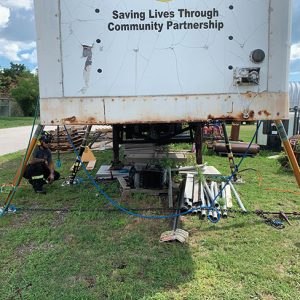
Extrication Tips: So many choices — Struts
Chad Roberts
Features editors pick Lightweight struts are easy to set up, but have their limitations. Photos: chad roberts
Lightweight struts are easy to set up, but have their limitations. Photos: chad roberts When thinking about our compliment of auto ex tools and how we evaluate our needs, the one area that is often overlooked or undervalued is the stabilizing and/or lifting struts. While some may argue this is due to their somewhat limited use on our general extrication calls, with the advent of newer struts on the market, today’s strut combinations put that argument to bed very quickly. From their original inception in the rescue world, these tools were used mainly for general stabilization and widening of the vehicle footprint (for more, see the October 2021 Extrication Tips). But now, struts, like many other tools in our trade, have been evaluated, re-engineered and rebranded to make them extremely versatile and valuable to any department, no matter the size or budget. The tricky part is knowing which one or type to go with.
That being said, I’m going to try and put a lot of the current strut types into specific categories so we can have a better idea of not only their capabilities, but which might work best for your department. I’m going to stay away from endorsing any exact brand, and stick more to type and function to avoid any bias. We’ll not only touch on versatility and function, but also its relative ease of use. And finally, another area of evaluation that we tend to forget is weight and how it fits into your apparatus.
So, let’s start with our light stabilizing struts. These are products such the Holmatro V-Strut and Junk Yard Dog Xtend strut. I love these type of struts because of how light and simple they are to use. They generally take up very little room on your apparatus and don’t require a ton of user knowledge to understand the basic application principles. The downside of these struts is that they are specifically designed for stabilizing loads. And while they can carry a weight rating from 4000 to 6000 pounds, we must keep in mind that these both use straps, not chains. Therefore, the working load limits of these straps will generally be our weak point.
Next up is our very versatile medium range strut. This class includes various models such as the Res-Q-Jack and the Rescue 42 strut. This is considered our middle class because these specific struts not only bring in a heavier WLL ranging from 10,000 to 18,000 pounds, they both can have fixed strut jacks attached to the unit that can be used to convert from stabilizing to lifting anywhere from 6000 to 8000 pounds. And while thinking about our lighter strut category, these can generally be used in conjunction with chains as well as straps, which gives us more peace of mind when talking about our weakest links.
Last but not least is the heavy hitters. These are common strut brands such as Paratech grey and gold series, as well as the Holmatro PowerShore hydra struts. This group of struts are capable of lifting loads from 20 to 25000 pounds and stabilizing loads over 100000 pounds. On top of that, these strut packages can be fitted with a multitude of different heads, bases and extensions to accommodate use not only in the extrication world, but to trench, structural collapse and even rope rescue. While these features are very attractive and seem like the ultimate winner hands down, we must be cognizant of the fact that more features and capabilities come with a lot more training required to fully understand and safely use these in such intense loading situations. A quick example of this may be the difference between air powered and hydraulic powered strut options. While the hydraulic option gives us much greater lifting capacity, the air powered options may be more suitable to stabilizing (“or chasing”) the lift. Also, the extreme power of the hydraulic lift will be too much for such applications as trench rescue, whereas the air powered are usually the preferred choice.
So, when dealt the with the ultimate conundrum of which is best for your department or rescue team, what does this all really mean? To break it down simply in relation to auto extrication, I go to what kind of vehicle each strut is capable of being applied to. The lightest category is generally used for passenger cars and light duty 1500 series pick-ups. The medium range strut gets you into safely lifting the cars previously mentioned while safely stabilizing heavier vehicles such as buses and cargo vehicles. And if you need the ultimate lift and stabilizing you go to the heavy weight category. Where these are specifically more capable are the transport truck incidents and vehicle under rides which we are seeing more and more on our roadways.
All being said, we don’t always have to settle every argument by weight. We must keep in mind simplicity of use and training required to maintain operational knowledge. How many moving parts are involved or included? Is there a bag or full cache of parts that go with the strut that can easily be stored, lost or confused? Or is it more convenient to have everything attached to the strut itself. Is the actual weight and size of the strut a concern when trying to figure out if it will fit on your specific apparatus? And at the end of the day, what are your mutual aid department capabilities or do you have easy access to heavy tow that may ease your mind when it comes to those heavier lifts.
So, there you have it, a small glimpse into the world of struts. While I wasn’t able to include all brands and models, you can clearly see that there are differences.
Before you commit, know your area, the applications you need them to apply to and versatility you’d like in your strut package to have going forward.
Please take this as a guide. Contact your local tool reps to help you make the best decision for your team.
Chad Roberts is a firefighter in Oakville, Ont. He is a member of the Oakville extrication team and competes and trains across North America. Contact Chad at chadroberts12@gmail.com.
Print this page

